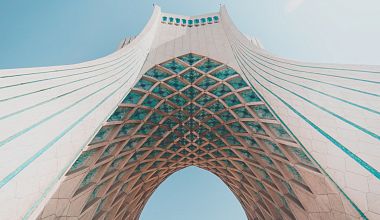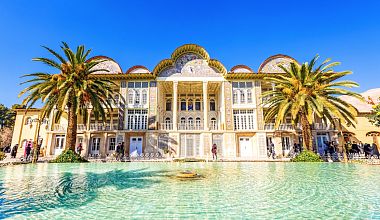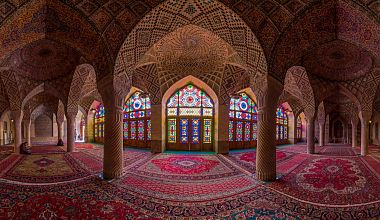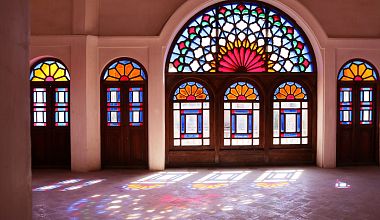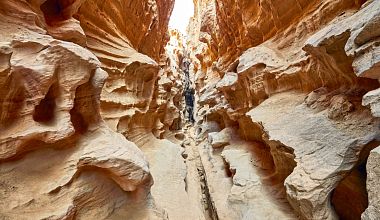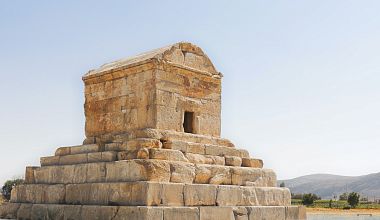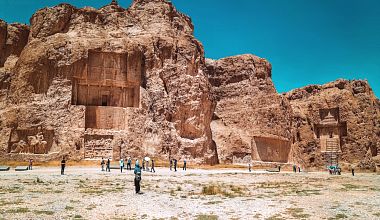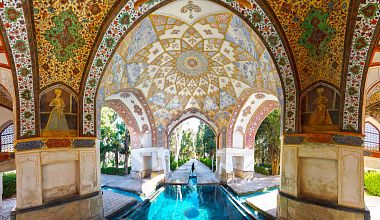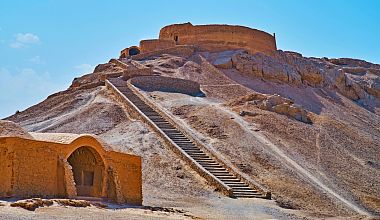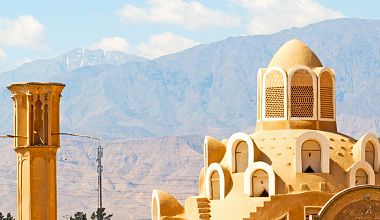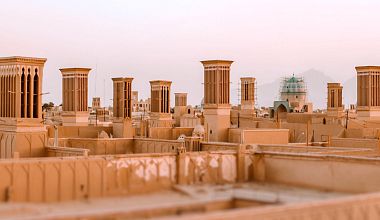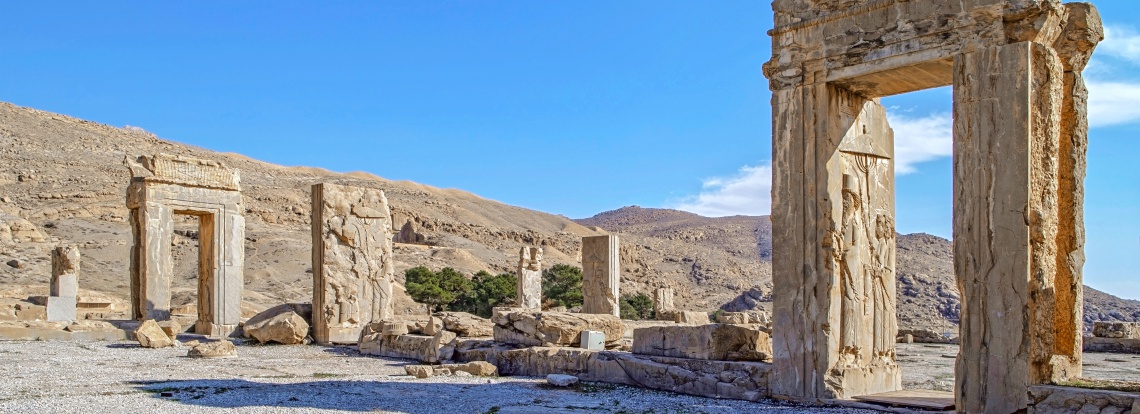
Why you should go on the sightseeing tour of Iran:
- to visit 5 UNESCO World Heritage sites;
- to trace the cycles of the rise and fall of empires and civilizations;
- to see how the art of conquered nations, transforming, created a new distinctive identity for the conquerors;
- to understand how and why events of past centuries are once again reflected in modern news headlines;
- to understand how lives one of the most mysterious countries in the world.
On the sightseeing tour of Iran we will:
- visit the palace complexes of the Persian Shahs from the Achaemenid (705-330 BC), Safavid (1501-1736 AD), Zand (1753-1794 AD), and Qajar (1795-1925 AD) dynasties;
- follow the path of kings and envoys through the ruins of ancient Persepolis, destroyed by Alexander the Great;
- discuss how the teachings of Zoroastrianism on good thoughts, good words, and good deeds defined the principles of state and political governance in the multicultural Achaemenid Empire;
- compare the scale and architecture of the tombs of Cyrus the Great, Hafez, and Imam Khomeini;
- read the lines from the poem "Gulistan" by the poet Saadi, embroidered in gold letters on a handmade Persian carpet in the United Nations headquarters building;
- find out which elements of European architecture, borrowed during the Qajar dynasty, were harmoniously integrated into the interiors of mosques and the homes of Iranian nobility;
- enjoy the beauty of the night sky on the edge of the Dasht-e Kavir desert.
Arrival in Tehran, Golestan Museum
Your guide will meet you at the airport, and you will be transferred to your hotel to rest. The tour will begin at 10-11 AM with a visit to the Golestan Museum.
The Golestan Palace complex will send us to 18th-19th century Persia, during the rule of the Qajar dynasty. Traditional elements of Eastern architecture, such as wind towers and iwans adorned with bright, hand-painted ceramics in traditional patterns, unexpectedly intertwine with European scenes and attributes of European lifestyle. This fusion reflects the fashion for European things within the ruling circles of the Qajar dynasty.
Next, you will visit the Tabiat Bridge, the Park of Fire and Water.
Funicular Ride to Tochal Peak, Visit to the Last Shah's Palace, Departure for the Desert
Early in the morning, after breakfast, you will head north to Tochal Peak for a funicular ride. After a lunch break, you will visit the summer residence of the last Shah of Iran.
In the evening, departure to the eco-hotel in the desert. Desert tour. Rest.
Departure in the morning for the ancient city of the Zoroastrians – Yazd.
In the morning, on the way to Yazd, you will visit the cities of Na’in and Meybod, where you will see the Narin Castle, water mills, and old mosques. You will learn how the Persians managed to solve water issues in the desert even before our era.
Closer to the evening, you will take a walk through the ancient city of the Zoroastrians – Yazd.
Yazd is older than the Egyptian pyramids and a contemporary of biblical Babylon.
It is one of the oldest cities in the world, having preserved its traditional architecture to this day. The historic city centre is included in the UNESCO World Heritage List.
Yazd
After breakfast, you will learn about one of the oldest religions, Zoroastrianism, at the Fire Temple, and visit the burial pits – the Towers of Silence.
After lunch, you will take a walk through the city centre and visit the main attractions of Yazd. Like many Iranian cities, Yazd is a maze of narrow alleys built entirely from mud bricks and adobe. The city is known for the largest network of qanats in the world – an ancient system of underground shafts and wells that supply water from the mountains via pipes laid many kilometres underground. Many houses are equipped with wind towers (badgirs) for ventilation, and yakhchals serve as primitive refrigerators. The heart of the city's life is the bazaars of the Old City, where mosques, baths, caravanserais, and schools coexist with trade shops. Among them stands out the Grand Friday Mosque (Jameh) with a library housing ancient manuscripts, and the Amir Chakhmaq Mosque.
Departure for Shiraz
After breakfast, departure for Shiraz. On the way, we will make a wish at the ancient cypress tree, which is over 4,500 years old.
Photoshoot at Nasir al-Mulk Mosque, visit to the historical landmarks of Shiraz.
In the very heart of Iran, in the Fars province, lies the city of blooming gardens, poetry, and wine – Shiraz. Its beauty was celebrated in the verses of the great Persian poets, Hafez and Saadi. The tombs of the poets have become cultural landmarks of Shiraz, attracting pilgrims from all over the world in hopes of touching ancient sanctities and uncovering the mysteries of the Persian soul.
As the locals say, it's hard not to be a poet in Shiraz.
At dawn, you will head for a photoshoot at Nasir al-Mulk Mosque. It is best to visit the mosque early in the morning when the first rays of sunlight, filtering through the colourful stained glass, fill the hall with various shades of colours and patterns.
After a breakfast break, you will continue your tour of Shiraz, learn about Persian poetry, visit the city's landmarks, and discover Sufism and its followers.
Sightseeing tour of Persepolis. Departure for Isfahan.
After breakfast, departure for Isfahan. Visit to the ancient capitals of the Persian Empire, Persepolis and Pasargadae, and the tombs of Naqsh-e Rustam.
The vast Achaemenid Empire, stretching from the eastern Mediterranean and Egypt to the Indus River in India, is considered the first empire characterised by respect for the cultural diversity of its peoples. This respect is reflected in Achaemenid architecture, which became a generalized representation of the various cultures within the empire.
Walk to the Si-o-se-pol Bridge.
Sightseeing tour of Isfahan.
The introduction to the city will begin with a visit to Isfahan's main landmark – Naqsh-e Jahan Square.
The square was built in the early 17th century and is an architectural ensemble that includes the Shah Mosque, Sheikh Lotfollah Mosque, Ali Qapu Palace, and the bazaar arcades. All the architectural monuments facing the square are included in the UNESCO World Heritage List. The 17th-century Shah Mosque, which was renamed Imam Mosque after the Islamic Revolution, is the place of particular interest.
The mosque building, topped with a double-layered dome, is adorned with glazed tiles in turquoise, blue, and azure colours. At the entrance to the mosque, there are two massive minarets, nearly 42 metres tall.
After the walk around Naqsh-e Jahan Square, you will visit Sheikh Lotfollah Mosque and Vank Cathedral.
In the evening, you will take a stroll through the Armenian district of New Julfa, visiting the Si-o-se-pol and Khaju bridges.
Sightseeing tour of Isfahan, shopping for souvenirs.
In the morning, you will visit the ancient Friday Mosque, which is included in the UNESCO World Heritage List, and the Chehel Sotoun Palace. After lunch, there will be time for shopping for souvenirs.
Sightseeing tour of Abyaneh, departure for Kashan.
In the morning, you will head to the village of Abyaneh. The village is famous for its unique architecture, with houses built from red clay, as well as its culture and customs, which differ from those of central Iran.
Among the residential houses in the settlement are the ruins of a medieval military fortification, as well as a fire temple, mosques, pilgrimage sites, and three citadels. The locals follow a particular traditional dress style and adhere to the ancient religion of Zoroastrianism. Women wear traditional costumes. There is a production of souvenir handicrafts, and the locals continue the tradition of hand weaving.
After the walk around Abyaneh, you will continue your tour to Kashan.
Departure for Tehran. Sightseeing tour of Kashan.
Since ancient times, the city of Kashan has been located at the crossroads of trade routes. Caravans, tired from long journeys, would first head to the Persian baths. These places were not only for relaxation but also served as meeting spots where deals were discussed and negotiations took place. One such place was the historic Amir Ahmad Bathhouse. The building of the hammam is decorated with mosaics and frescoes worthy of a royal palace. This is where you will begin your exploration of the city.
In the evening, you will head to Tehran, to a hotel near the airport, to rest before your flight.
Departure for home
- Tehran
- Kashan
- Isfahan
- Yazd
- Shiraz
- English speaking guide
- Transfer
- Accommodation in a 4-5 star hotel with breakfast
- Travel insurance
- Iranian visa
- International flights
- Lunches and dinners

